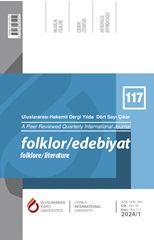Ali Şir Nevâyî’nin Biyografi/Tezkire Türündeki Risalelerinin Binası, Ağıt ve Hatırat Üslubu, Ölüm Ritüelleri
The Works of Ali-Shir Nawa’i in the Genre of Biography/ Hagiography, Elegy, and Memoir Style, Death Ritual
Author(s): Tanju Oral SeyhanSubject(s): Studies of Literature, Theology and Religion, Turkish Literature, Stylistics
Published by: Uluslararası Kıbrıs Üniversitesi
Keywords: Ali-Shir Nawa’i; Seyyid Hasan-ı Erdeshir; Halat-ı Seyyid Hasan Big; Abdurrahman Jami; tazkira (biographical dictionaries); death;
Summary/Abstract: Ali-Shir Nawa’i is a “mastermind” who has left various milestones in Turkish literature. His compositions, “Halat-i Seyyid Hasan Big” for the scholar and mystic Seyyid Hasan-i Erdesir; “Halat-i Pehlevan Muhammed” for the poet, composer, physician, and Sufi Pehlevan Muhammed; and the biographical treatises “Hamsetu’l-mutehayyirin” for Molla Jami, a member of the Naqshbandi Sufi order who wrote in Persian and Arabic, are among the earliest examples of the biography genre. These works are not only biographies in a technical sense but also possess the characteristics of elegy and memoir. In this study, the treatises were evaluated to understand the construction and some stylistic features of the biography genre laid down by Ali-Shir Nawa’i, a master builder and composer. Although these treatises have been published in Turkey, translated into Turkish, and a dictionary-index has been prepared, there has been no text analysis from various perspectives such as grammar, cultural history, etc. After Ali-Shir Nawa’i, it was observed that these characteristics were applied in biographical writing in later hagiographies, whether focusing on a single individual or multiple individuals. Biographies, memoirs, and prose elegies written for ancient friends and revered figures in Turkish cultural life, bearing the characteristics of the mentioned treatises, also include customs and vocabulary related to death depending on the purpose of writing. In this article, an attempt is made to determine the construction of memoirs and stylistic features by examining some of Nawa’i’s works, “Munshaat,” “Majalisu’n-Nafayis,” and “Muhakamatu’l-Lugatayn.”
Journal: Folklor/Edebiyat
- Issue Year: 30/2024
- Issue No: 117
- Page Range: 141-166
- Page Count: 26
- Language: Turkish

